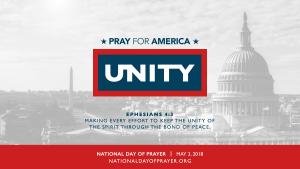 Thursday, May 3, 2018, marks the 67th annual observation of the National Day of Prayer in America. But at my kids’ public junior high school, every Thursday morning is devoted to prayer.
Thursday, May 3, 2018, marks the 67th annual observation of the National Day of Prayer in America. But at my kids’ public junior high school, every Thursday morning is devoted to prayer.
My twelve-year-old daughter founded and leads a weekly morning prayer club before the bell rings. As a parent, I find both the national event and the school meeting interesting, but the latter much more exciting.
What is the National Day of Prayer all about? Organizers point out that public prayer and national days of prayer enjoy a long-standing and significant history in America. The Supreme Court affirmed the right of state legislatures to open their sessions with prayer in 1983 (Marsh vs. Chambers). Since George Washington, presidents have issued informal calls to national prayer many times. In 1952 a joint resolution by Congress declared an annual national day of prayer, which President Truman signed. Reagan’s amendment in 1988 set the day as the first Thursday of every May. It is open to followers of any faith.
What is the Junior High Prayer Club all about? A group of students opt to attend a short prayer time before school on Thursdays during the school year. Maggie, my daughter, told my husband and me during the fall semester that she wanted to inaugurate such a group, so we explained the process for getting permission to start a club. She went through all the proper channels to gain approval, a location, a staff “sponsor” (a responsible adult who agrees to attend), and ways to promote to fellow students. In December 2017, the first session of the Prayer Club met in the school library with about 20 attendees.
What happens on the National Day of Prayer? Nation-wide, state and local governments, civic organizations, churches, and private groups will gather for a unified prayer time. This year’s theme, in fact, is unity—#pray4unity hashtags will abound on social media, and organizers will offer prayers for unity in the country, the church, families, ethnicities, and agreement on anticipating a new spiritual awakening in the country. Organizers provide multiple tools on their website, including the following video:
What happens at the Junior High Prayer Club? Maggie originally conducted business by explaining the importance of prayer, reading a few verses about prayer, then organizing the students into smaller groups with suggestions on what to pray about. Since it started shortly before Christmas, she spent a few minutes in the second and third meetings reading a short portion of the Nativity before prayer time. In January, when they resumed meetings, she continued to focus on Bible stories, loosely following Jesus’s life (getting lost in the temple at age 12, a parable or two, and closer to Easter the Passion stories) as well as a few Old Testament passages. Often she would give background information before the scripture reading, a pattern that has morphed into actual teaching. The meetings moved from “short reading/longer prayer” to “Maggie teaching for 10 minutes/10 minutes for prayer.” Now, as the semester draws to a close, she spends 15 minutes teaching and only five on prayer. Enjoy this clip:
Why I Find the Junior High Prayer Club Exciting
Of course, the school club overshadows a national movement because my daughter leads it. Life happens locally, right? I am highly motivated to support Maggie. We talk weekly about how the meeting went, what she taught on, what she plans to teach on the next week, how the prayer portion goes, etc. She knows that her dad and I support her wholeheartedly. Her success doesn’t depend on how many students attend, or how well she organizes each meeting. How do we define success?
- She obeyed the Spirit leading her: She thought about this for several weeks before telling us about her plans. She felt prompted to do it, not knowing how it would be received. Would the administration allow it? Would anyone attend? Would they stay? What sort of leader would she be? She didn’t know, but she walked in faith.
- She learns leadership: Starting anything means risking failure, but leaders must risk failure in order to succeed. Initiating and leading a weekly group requires Maggie to plan ahead, exercise group management skills, develop her public speaking abilities, ask for help, organize a Bible lesson, and risk criticism.
- The gospel goes forth to the next generation: My favorite “win” here relates to the kids participating in the group. They hear the Bible preached from someone their own age modeling an active faith. They choose to attend (unlike church, which most parents make compulsory). They start their day with Scripture on their minds. Some have even been inspired to branch off and create different clubs more focused on Bible study.
So let’s join with millions across the nation on the first Thursday of May to pray for unity in our country, among races, in our churches, and in our families. We have much work to do. Perhaps the two dozen pre-teens gathered to pray every Thursday morning are on to something: we don’t need to go to D.C. or state capitals to encourage positive change. We can join hands with friends and family any day of the week and turn to our heavenly Father with worship and petition.












